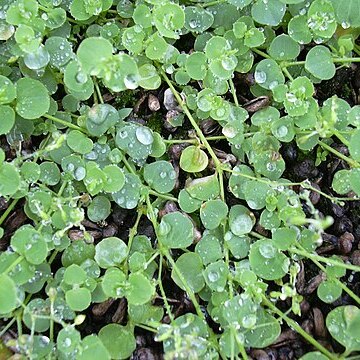Annual or perennial, glabrous to pubescent herbs, occasionally subligneous below, prostrate, spreading or erect. Leaves opposite, with persistent or fugaceous small stipules, sessile or petiolate, glabrous to villose, the hairs often glandular. Flowers in few-flowered racemes or in dichasial cymes, rarely solitary in the axils. Sepals 5, not connate. Petals (0-) 5, white, usually 2-cleft, with the sinus of the cleft occasionally laciniate. Stamens 2-5, the anthers versatile, 2-celled, the flat-tened filaments slightly connate at the base, rarely with prominent staminodia. Ovary superior, slightly stipitate; carpels 3, the 3 styles united below; ovules few-many, campylotropous on free central placentae. Capsule ovoid to spheroid, dehiscing into 3 entire valves; seeds l-many, cochleate, foetiform or hippocrepiform, usually tuberculate, the embryo curved about the perisperm.
Annual or perennial herbs; stems slender, usually prostrate, spreading, glabrous or pubescent, sometimes rooting at nodes. Leaves opposite or subverticillate; petiolate; stipules small, scarious, often persistent or falling off rapidly; blade glabrous to villous with often glandular hairs. Inflorescences few-flowered mono-or dichasial cymes; bracts scarious. Sepals 5, free, herbaceous with scarious margin; petals (0-3)5, white, often deeply bifid, sinus sometimes laciniate; stamens 2-5, filaments somewhat connate, flattened; ovary ovoid, sessile or substipitate, 1-locular, ovules few, campylotropous on free central placenta, 3 styles united at base. Fruit an ovoid, 3-valved capsule; seeds 1-numerous, globose-reniform, cochleate or hippocrepiform, usually granular or tuberculate, rarely smooth.
Annual or perennial, glabrous or pubescent herbs. Stems slender, prostrate or erect, sometimes rooting at the nodes. Leaves opposite, stipulate, glabrous to villose or glandular; petioles short or long; stipules small, filiform, often caducous; lamina ovate-reniform with hydathodes. Inflorescence a dichasial cyme, rarely an axillary cluster or flowers solitary. Flowers hypogynous or subperigynous. Sepals (4 or) 5, free, with scarious margins. Petals (3-)5, white, usually bifid, rarely wanting. Stamens 2-5, often some of them reduced to staminodes, filaments ± flattened, anthers versatile. Ovary shortly stip-itate, styles 3, rarely 2 or 4, ± united in lower part; ovules few to many. Capsule spherical, dehiscing by 3 valves. Seeds usually tuberculate or verrucose.
Herbs annual or perennial. Stems creeping or suberect, with dichotomous branching. Leaves opposite, shortly petiolate; leaf blade orbicular or ovate-cordate, 3--5-veined; stipules small, bristly, often fugacious. Inflorescence a cyme, terminal. Flowers (4-or)5-merous, pedicellate, small. Sepals free, green, herbaceous. Petals absent or (1--)3--5, 2-lobed, occasionally appendiculate in sinus and/or auriculate at top of claw. Stamens (2--)5, opposite sepals; filaments joined at base. Ovary with few ovules; styles (2 or)3, joined at base. Fruit a capsule, (2-or)3-valved, 1-to many seeded. Seeds ovate or reniform, small, flat; testa tuberculate.
Herbs, annual to perennial, prostrate to erect, glabrous or pubescent. Leaves opposite or pseudoverticillate, linear to elliptic; stipules lacerate-attenuate, scarious; bracts sub-herbaceous, with broad, scarious margins. Flowers few to many in dichasial cymes, usually 5-merous, bisexual. Sepals 5, free. Petals 3–5, usually bifid, rarely absent, white. Stamens 2–5. Ovary 1-celled, with few to many ovules; styles 2 or 3, fused at the base for ± 50% of their length. Capsule globose to ovoid, opening by 3 valves. Seeds 1–8 (–many, but not in Australia), lacrimiform, obovoid or nautiloid, tuberculate.
Herbs. Leaves flat, opposite, with small stipules. Flowers small, solitary, in the axils of leaves or forming a cyme terminal to the branches; receptacle slightly perigynous. Sepals (4–) 5, free. Petals (4–) 5, deeply bisegmented. Stamens 5 or fewer, filaments shortly connate at base. Ovary unilocular with 2-numerous ovules; styles 3, connate below. Capsule with 3 valves.
Flowers small, solitary in the leaf-axils or in usually rather loose cymes at the ends of the branches.
Stamens 5 or fewer by abortion, ± perigynous, filaments shortly connate at the base.
Leaves flat, opposite (in our species petiolate); stipules small, often caducous.
Petals (4) 5, deeply bifid, the lobes sometimes themselves lobed.
Ovary 1-locular, 2-?-ovulate; style with 3 stigmatic arms.
Sepals (4) 5, sometimes with a scarious margin.
Dichotomously branching herbs.
Capsule 3-valved.

